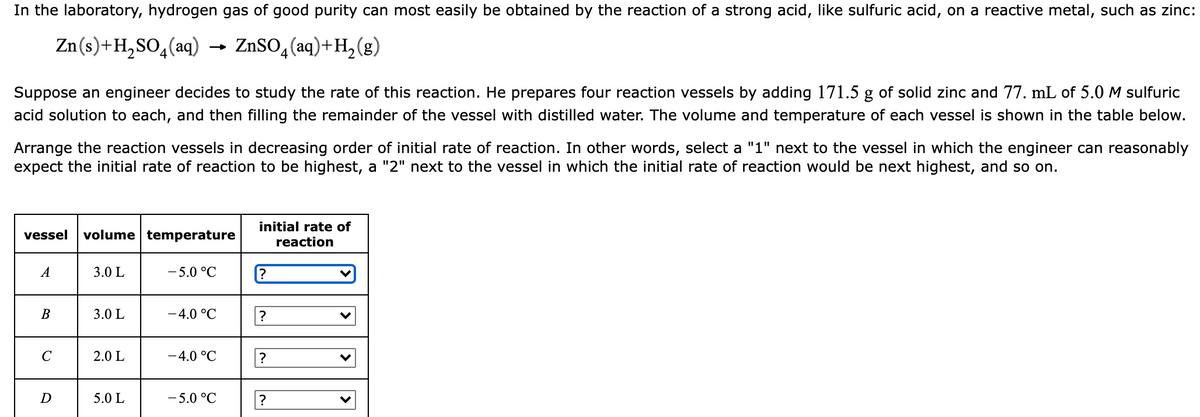In the laboratory, hydrogen gas of good purity can most easily be obtained by the reaction of a strong acid, like sulfuric acid, on a reactive metal, such as zin Zn(s)+H,SO,(aq) ZnSO,(aq)+H,(g) Suppose an engineer decides to study the rate of this reaction. He prepares four reaction vessels by adding 171.5 g of solid zinc and 77. mL of 5.0 M sulfuric acid solution to each, and then filling the remainder of the vessel with distilled water. The volume and temperature of each vessel is shown in the table below Arrange the reaction vessels in decreasing order of initial rate of reaction. In other words, select a "1" next to the vessel in which the engineer can reasonably expect the initial rate of reaction to be highest, a "2" next to the vessel in which the initial rate of reaction would be next highest, and so on. vessel volume temperature initial rate of reaction A 3.0 L -5.0 °C B 3.0 L -4.0 °C 2.0 L -4.0 °C 5.0 L - 5.0 °C
In the laboratory, hydrogen gas of good purity can most easily be obtained by the reaction of a strong acid, like sulfuric acid, on a reactive metal, such as zin Zn(s)+H,SO,(aq) ZnSO,(aq)+H,(g) Suppose an engineer decides to study the rate of this reaction. He prepares four reaction vessels by adding 171.5 g of solid zinc and 77. mL of 5.0 M sulfuric acid solution to each, and then filling the remainder of the vessel with distilled water. The volume and temperature of each vessel is shown in the table below Arrange the reaction vessels in decreasing order of initial rate of reaction. In other words, select a "1" next to the vessel in which the engineer can reasonably expect the initial rate of reaction to be highest, a "2" next to the vessel in which the initial rate of reaction would be next highest, and so on. vessel volume temperature initial rate of reaction A 3.0 L -5.0 °C B 3.0 L -4.0 °C 2.0 L -4.0 °C 5.0 L - 5.0 °C
Chemical Principles in the Laboratory
11th Edition
ISBN:9781305264434
Author:Emil Slowinski, Wayne C. Wolsey, Robert Rossi
Publisher:Emil Slowinski, Wayne C. Wolsey, Robert Rossi
Chapter42: Rate Studies On The Decomposition Of Aspirin
Section: Chapter Questions
Problem 1ASA
Related questions
Question

Transcribed Image Text:In the laboratory, hydrogen gas of good purity can most easily be obtained by the reaction of a strong acid, like sulfuric acid, on a reactive metal, such as zinc:
Zn(s)+H,SO,(aq)
ZnSO, (aq)+H,(g)
4
4
2.
Suppose an engineer decides to study the rate of this reaction. He prepares four reaction vessels by adding 171.5 g of solid zinc and 77. mL of 5.0 M sulfuric
acid solution to each, and then filling the remainder of the vessel with distilled water. The volume and temperature of each vessel is shown in the table below.
Arrange the reaction vessels in decreasing order of initial rate of reaction. In other words, select a "1" next to the vessel in which the engineer can reasonably
expect the initial rate of reaction to be highest, a "2" next to the vessel in which the initial rate of reaction would be next highest, and so on.
initial rate of
vessel
volume temperature
reaction
A
3.0 L
- 5.0 °C
?
В
3.0 L
-4.0 °C
?
C
2.0 L
-4.0 °C
D
5.0 L
- 5.0 °C
?
>
>
>
Expert Solution
This question has been solved!
Explore an expertly crafted, step-by-step solution for a thorough understanding of key concepts.
This is a popular solution!
Trending now
This is a popular solution!
Step by step
Solved in 3 steps with 3 images

Knowledge Booster
Learn more about
Need a deep-dive on the concept behind this application? Look no further. Learn more about this topic, chemistry and related others by exploring similar questions and additional content below.Recommended textbooks for you

Chemical Principles in the Laboratory
Chemistry
ISBN:
9781305264434
Author:
Emil Slowinski, Wayne C. Wolsey, Robert Rossi
Publisher:
Brooks Cole

Chemistry: The Molecular Science
Chemistry
ISBN:
9781285199047
Author:
John W. Moore, Conrad L. Stanitski
Publisher:
Cengage Learning

Chemistry
Chemistry
ISBN:
9781305957404
Author:
Steven S. Zumdahl, Susan A. Zumdahl, Donald J. DeCoste
Publisher:
Cengage Learning

Chemical Principles in the Laboratory
Chemistry
ISBN:
9781305264434
Author:
Emil Slowinski, Wayne C. Wolsey, Robert Rossi
Publisher:
Brooks Cole

Chemistry: The Molecular Science
Chemistry
ISBN:
9781285199047
Author:
John W. Moore, Conrad L. Stanitski
Publisher:
Cengage Learning

Chemistry
Chemistry
ISBN:
9781305957404
Author:
Steven S. Zumdahl, Susan A. Zumdahl, Donald J. DeCoste
Publisher:
Cengage Learning

Chemistry: An Atoms First Approach
Chemistry
ISBN:
9781305079243
Author:
Steven S. Zumdahl, Susan A. Zumdahl
Publisher:
Cengage Learning


Chemistry for Engineering Students
Chemistry
ISBN:
9781337398909
Author:
Lawrence S. Brown, Tom Holme
Publisher:
Cengage Learning